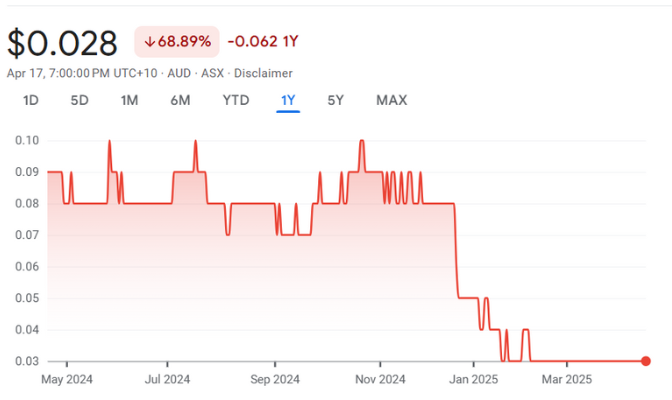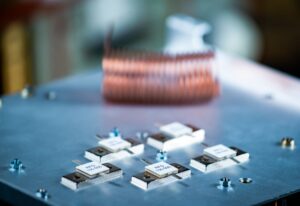4DS Memory Ltd
(ASX: 4DS)Share Price and News

About 4DS Memory Ltd
4DS Memory Ltd is an Australian-based company focused on developing next-generation non-volatile memory solutions. The company is primarily engaged in the research and development of memory devices designed to provide faster, more reliable, and cost-effective alternatives to traditional flash memory technologies. 4DS Memory is paving the way for its proprietary technology to revolutionise sectors such as data storage, semiconductors, and computing.
Its key innovation, the 4DS Memory Technology, has attracted attention for its potential to enhance the speed and efficiency of memory storage, positioning it as a competitive player in the rapidly growing memory market. With a global footprint, the company is collaborating with industry leaders and testing its innovations to push the boundaries of existing memory systems.
4DS Memory Ltd Company History
Founded in 2007, 4DS Memory Ltd has consistently worked toward developing new memory technologies that can provide solutions for the ever-growing demand for faster and more efficient data storage. The company's journey has been marked by consistent research and development efforts, with significant milestones including the development of its proprietary memory technology.
4DS Memory has achieved notable success in attracting both public and private investment to fund its development pipeline. In recent years, the company has focused on advancing its technology through collaborations with other industry players, furthering its position in the semiconductor and memory market.
Future Outlook of 4DS Memory Ltd (ASX: 4DS)
The future outlook for 4DS Memory Ltd (ASX: 4DS) appears promising based on its technological advancements and industry trends. As the demand for data storage solutions continues to increase, 4DS Memory’s innovations in non-volatile memory could become key in meeting the needs of various sectors, including consumer electronics, enterprise storage, and even emerging applications like artificial intelligence (AI).
While exact revenue forecasts are not publicly disclosed, the ongoing development and testing of its memory technologies should set the stage for future revenue generation. Industry analysts expect increasing demand for memory products, offering a potential boost to the company's earnings. The global semiconductor industry is also expected to continue its expansion, driven by demand in mobile devices, cloud computing, and AI applications.
4DS Memory is well-positioned to benefit from this trend, especially with its advancements in memory technologies that aim to enhance data storage and processing speeds. 4DS Memory's ongoing research and development efforts, coupled with strategic partnerships, are poised to drive its expansion. The company has been focusing on scaling its technology and collaborating with key industry players, setting the stage for future product launches and commercialisation.
However, despite the promising outlook, 4DS Memory faces risks typical for emerging tech companies, including technology development timelines and competition. Additionally, the broader economic environment and semiconductor supply chain challenges could impact its progress and market positioning.
Is 4DS Memory Ltd (ASX: 4DS) a Good Stock to Buy?
When evaluating whether 4DS Memory Ltd (ASX: 4DS) is a good stock to buy, several factors need to be considered. 4DS Memory's current valuation reflects its high-growth potential in the memory technology market. While still in the development phase, its technology holds promise, particularly as data storage requirements grow across industries.
As of now, 4DS Memory does not offer a dividend, focusing its resources on research and development. Investors seeking income through dividends may need to look elsewhere, but those interested in high-growth stocks could find potential in the company’s future. As a tech-focused company, 4DS Memory carries a higher risk due to its reliance on the successful development and commercialisation of its technology.
However, the potential rewards are substantial, especially if the company can secure partnerships and bring its innovations to market. Given the increasing demand for advanced memory solutions, 4DS Memory is well-positioned for significant growth. Its focus on next-gen memory technologies could make it a key player in the rapidly evolving semiconductor market.
While specific analyst ratings are limited, industry trends and 4DS Memory’s continued R&D success indicate a cautiously optimistic outlook for its long-term growth. Potential investors should monitor its technological progress and industry developments for clearer investment signals.
Our Stock Analysis
Here’s what investors need to know about ReRAM and how ASX chip stocks can make big bucks from it!
Our longer term readers would know we are big fans of Weebit Nano (ASX:WBT), a company commercialising its own version…
ASX Semiconductor Stocks: An Ultimate Guide for Investors (2025 edition)
ASX Semiconductor Stocks are amongst the most complicated and volatile companies on the bourse, but also those with amongst the…
TSMC: The ~TW$30tn company that’s the reason why China has an eager eye on Taiwan
Have you ever heard of TSMC (Taiwan Semiconductor Manufacturing Company)? If you haven’t, there are good reasons why you should…
Mark the Pitt Street Research Semiconductor Conference 2025 in your calendars!
The Pitt Street Research Semiconductor Conference 2025 is coming up! Pitt Street Research in partnership with Bell Potter are thrilled…
Here’s why you should attend Semiconductor Australia 2024 – Australia’s premier semiconductor industry event
In 3 weeks time, on 24 October, Semiconductor Australia 2024 will take place in Sydney. Hosted by BluGlass, Sharecafe and…
Are Semiconductor stocks really so much more volatile than other stocks?
Semiconductor stocks are amongst the most important companies on the market. This is because they produce the components that enable modern…
Frequently Asked Questions
Currently, 4DS Memory does not offer a dividend, as the company reinvests profits into its research and development efforts to advance its memory technology.





